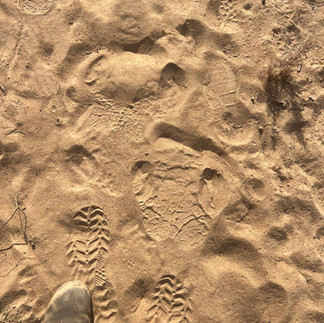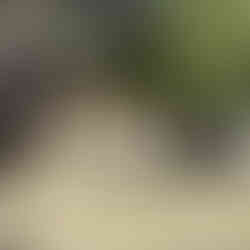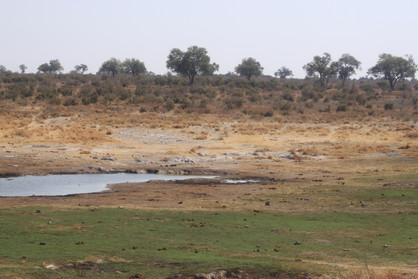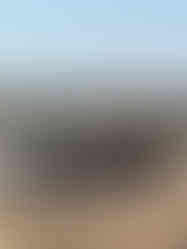Namibia part 8: Kalahari dreamland
- Guy Mavor
- Oct 28
- 11 min read
The far east: a Kalahari cultural break, with added wilderness

From Namutoni, it is a long drive to Nhoma. You can do it in a day, but that would miss a picturesque stop at Ghaub Guest Farm, a former Rhenish mission station, now a nature reserve and white rhino sanctuary at one end of a valley and cattle and maize farm – unusual in parched Namibia, but it rains here more than the rest of Namibia bar the Caprivi - at the other. Both areas cover around 10,000 hectares each. We stay one night but there is plenty to keep you busy for two. In retrospect, I would have done the accompanied rhino tracking rather than the self-guided walk on my own, which went through a beautiful acacia forest to a rock engraving but involved a few too many rhino tracks and heaps of dung for comfort. I think they let me go because they knew the rhinos were elsewhere. You can also explore a huge limestone cave and visit the farm. The staff are very friendly and welcoming, and the food is delicious, but it is noticeable that the owners live abroad. Perhaps it was just that there were only two other guests, a bodybuilder (jeez he was big) and his fiancée on a weekend break from Otjiwarongo, but the place felt a little lonely.
At Nhoma, 250km along a dirt road from Grootfontein, is our final stop before Windhoek. It is a safari camp, in beautiful, forested Kalahari duneland south of Khaudum National Park, but its siting is more about the village of the same name next door and the San culture it preserves simply by living it every day.

I realise I have been thinking about this trip (the Kalahari, its people) most of my life. My godmother used to send me Laurens van der Post books to read at night at boarding school (and a torch with extra batteries - she thought of everything). Re-reading the books later in life, I can see why he is seen as patronising, but the sense of excitement and escape as we drive is the same as when I settled down to read under the covers aged 11. There are also nerves. The world which van der Post described, and the Marshall family chronicled in great detail and from a deep sense of both curiosity and equality without the former’s main character complex, vanished long ago. Paul Theroux visited Tsumkwe just over a decade ago and wrote starkly about its desperate, alcoholic poverty. We saw some of this, and the truth is that there are not many sources of income out here in the far east of the country. Unless you run a shebeen. Many locals work as trackers and guides for lodges around the country and beyond. Their skills, as we will later see, are second to none. Near Nhoma, there is the San-Dal project, set up by one of the lodge’s current owners, Flora, which makes traditional sandals for Vivobarefoot. Otherwise, small-scale crafts provide a limited income to some, which land in the region is rented for tiny sums to Kavango cattle farmers or foresters, who clear it and take it over.
Growth in tourism is the hope here. Bushmanland is off the main tourist trail through Namibia, but I don’t see why it should be. Nhoma was the highlight of our trip-of-many-highlights. Add to it the wilds of Khaudum and – in the right season (earlier in the year, when there is still standing water) – the birder’s paradise of Nyae Nyae pans, and you have a huge and varied area to explore. It is beautiful at any time, wild but inhabited: not ‘pristine’ but with a rich cultural heritage.
Nhoma Safari Camp, owned since 2020 by Flora and Moritz Botha, is the standout accommodation option in the area, although there is a basic lodge in Tsumkwe and there are some picturesque campsites further south in the Nyae Nyae conservancy. The camp was set up in the 90s alongside Nhoma village by Arno Oosthuizen who initially ran trips to Khaudum from Tsumkwe Lodge but then gradually brought tourists into the village at their request, establishing a long association with the camp which has developed into a kind of symbiosis: a way of life and culture which for a long time was not able to be supported by the bush – nomadic habits and permanent settlement do not go together – is maintained, supported by tourism income. That relationship has been transformed by Flora and Moritz, with new generations of Ju’hoansi developing skills which bring them into the wider market economy and ‘hospitality management’ sphere in general. But it is their genuine warmth and the feeling of being hosted in their place, their culture and history, which makes a visit to Nhoma so special.

Cultural tourism can be done badly. There can be an uncomfortable interface between rich, gawking tourists and desperately poor people. In Namibia, cultural villages are a thing, but sometime a shallow, transactional thing, and usually brief. Even the best tours of Himba villages are just that: tours. Here, you are a bit more involved. We were only at Nhoma for 3 days, with Lils and I spending one of those in Khaudum, which I had always wanted to visit and was spectacular, but part of me envied Sian, who stayed behind in the village, made an ostrich shell necklace with a group of ladies and laughed a lot. On our two other visits to the village, adults simply got on with what they were doing, children played, and we fitted in. We also went out walking.

Bush skills
The second day, we drive out 20 kilometres into the bush with two groups of hunters, not just for a walk, but to read its signs, perhaps to hunt. It depends on what they find, or read. One carries a long pole to dislodge honey from crevices in trees, others bows and quivers made from duiker skin. We are in a gently undulating landscape of dried grasses and low bushes, with large hardwood trees – leadwood, camel thorn acacia – providing the canopy in this low-density forest, their leaves still mostly green. There were good rains this year. The ground is soft and sandy, with tracks harder to spot, but there are still signs. We are shown flattened grass where a small herd of wildebeest lay down to sleep some time ago. The droppings are dry and tell us it was 3 weeks ago. So far, so obvious (ish…). But then we are told the direction they came from, where they were going and why they stopped here. The clues to this were obvious to the hunters, invisible to us (elevation? Direction grass was flattened? Prior knowledge? It seems more like sorcery but the signs are there, our guide James says, and the hunters are not there to impress us, let alone lie to us. We are just tagging along, which is lovely). We keep moving, looking in abandoned burrows and branches of trees. The men move quickly, softly, so it is all we can do to keep up with them. They occasionally stop to confer, then spread out, each scanning different levels – ground, branches, canopy. Sometimes one or two fan out away from the group and circle back after a while. I try to follow what they are looking at, but also find myself staring up at huge tree canopies, the blue sky, or simply at the figures moving in front of me, chatting quietly. They are having a great time, even if they haven’t found a porcupine, as sometimes happens. I am glad they haven’t, and they are not disappointed either, masters of equanimity that they are, of simply living in the moment.

We stop after an hour and one of the hunters chooses a spot in the sand and starts digging. After a couple of minutes he produces a tuber the size of a football and proceeds to scrape the skin off before squeezing bitter drops of water out of its handfuls of its fleshy centre. There is no surface water for most of the year in the Kalahari, so this is one way to stay hydrated, along with bitter melons which sit above the surface.
We sit down and the hunters start to work on making fire from nothing more than dried grass and the application of friction by quickly rolling a stick back and forth between the palm of their hands. I have a go, and get it eventually, much more slowly and clumsily than they do. They also prepare a snare trap. Not a wire one but one made from scratch with available materials: fibrous grasses, like mini sisal leaves, are scraped repeatedly then rolled into strands, before being woven together into a thin rope (or thick string). This takes the time it takes – there is no hurry but rather, with a small fire now burning, the opportunity for a smoke – tobacco rolled up loosely in newsprint – and a chat. Eventually, a stick is broken off a bush, a branch is bent to the ground and a spring-loaded trap is set. Lily is invited to test it. It springs up and catches her wrist.
In the afternoon back at the village, we sit with the same men as they make arrows from scratch. The one concession to modernity is the strand of fence wire which is flattened and sharpened into an arrow tip. Again, it is slow, deliberate, and above all sociable work. At the end, one of the men hands it to me with a smile, a gift. James is on hand to translate. He says he cannot use it here, as he is not allowed to hunt. Perhaps I am imagining a twinkle in his eye which suggests that he might, anyway. There is a lot of fun to be had in the village, as Sian can attest from her jewellery making session, and can be seen from the kids running around. Flora and Moritz’s daughter spends a lot of her days in the village. There are more serious, reflective moments too, as we see on the last evening.

The Healing Dance
There comes a moment in the healing dance when the percussive repetitions and chants of the women becoming a part of the men as they lose a hold their conscious selves. Their own movement also leads up to the moment, a sort of shaking, focused, self-contained rapture, with none of the demonstrative elements you might expect. They are heading towards it, trying to bring it on, but they are not forcing it.
It would be harder to know what was happening without James, our guide, talking us through it. He is paying close attention to the three trembling figures with their backs to us. One of them is his brother, who he describes as an apprentice, learning how to channel his ancestors, how to draw on them for guidance and pass that on to the figures around the fire, to heal them by pulling the 'arrow of sickness' out of them, or even advise them. At one point I ask James what one of the men is saying to a seated figure, but he replies that he is too far away to hear. This might be a very polite none-of-your-business, but it could also be a straightforward answer to my question. Probably the latter, but I don’t ask again.
We are seated 3 metres behind the circle, observers, but the beat starts to hold my attention too. Not really on any sort of level below my conscious brain, and not exactly physically, but I can feel it in my limbs. It is enough for a disconnect between what I am observing and what my brain is doing, which is soaring, or at least rising, tethered to rationality. I am imagining the scene from above. My mind runs free (ish), and I think about what it would be like to fully let go of my immediate concerns and dive into my unconscious like these men are, tapping the knowledge stored within my brain but hidden by the clutter of everyday life. I would have clarity and certainty, perhaps. This is how I understand a trance state, or my best guess at what it would be like for me as a ‘rationalist’, a man with a cluttered mind. I remember something like it, a hedonistic version, from nightclubs 30 years ago: you lose yourself to the dance then suddenly it is morning and hours have passed. But I wasn’t seeking anything beyond passing the time more intensely, perhaps collectively, although in a 90s club everyone was a little lost in their own bliss as I remember.
It is different for the figures dancing. They seek to heal. I don’t believe you can channel your ancestors, but they and the people seated around them do. For them, the clarity and insights they channel comes not from what they know themselves but from the accumulated wisdom of their ancestors, a deeper well altogether. I can see that it lends weight to the message but also peace to the giver and receiver of said healing moment. With the shortfall or near-absence of modern medicine in the area, that is also a comfort, for me at least. I will label it a placebo effect not as a cynic but as an uncomprehending outsider, but I can also see that it is more than that, a balm to individuals and a ritual which also strengthens the collective. And if I have learned anything at all from this stay, the collective is all.
Khaudum
The gently-rolling Kalahari landscape continues into Khaudum, an under-visited park with forested and open areas, and has few facilities – or just enough, if you like your places wild: rudimentary game-viewing platforms are set up at natural clay pans and man-made waterholes.
We sit up at a two of these, watching a nursery herd of 10 or 12 roan antelope approaching at Omuramba waterhole, and a bathing bull elephant having the time of his life at Elandsvlakte (I think – I lost track of where we were on the map). The game is warier than at Etosha, less accustomed to vehicles. We only spot one other during the day, an Australian-registered V8 Landcruiser which has Moritz salivating. Or maybe that was me. It is an open park, ie with no fences apart from along the border with, which means game roams back and forth from the Caprivi, into adjacent farmland – another reason for the skittishness, as hunting happens here – or even across from the Okavango, only 150km from the eastern edge of the park, fence or no fence (it makes no different to many species – an elephant will just crash through, while a kudu or even eland will flow over it in a graceful leap). It sits up in the armpit of the Caprivi Strip (I mean: if you are looking at a map – I don’t mean it’s a shithole), with omurambas, seasonal/underground watercourses, still green at the end of July this year, which flow into the Xaudum, largely underground, which flows into the Okavango. The north of the park is wilder, the sand looser and trickier to drive on, than the dry savannah south. It should be fine in the dry season, but we don’t have time to get up there in one day and stick to the south. It would make an exciting trip, but you would need to be fully self-sufficient and travel in a convoy with a satellite phone and proper 4x4. There is a basic unfenced campsite in the northwest of the park at ‘Xaudum Lodge’ on the map (which is not a lodge but might be in future), and an actual lodge and campsite at Sikereti, which is just marked as a campsite on the map.
The park’s main attractions, apart from its wild landscapes, are wild dogs, which we don’t find, and are rarely seen. You can be lucky and come across a den at the beginning of the dry season, or you may see them later in the dry season, in late September or October before the rains, when water is scarce. We are happy to see roan, however, as well as oryx, kudu and several raptors and hornbills, other stars of the park, although we don’t see ground hornbills. The big attraction is the elephants, who gather in large numbers later in the dry season too. These can be aggressive, apparently. We come across a herd of 30 or so splashing about at a waterhole in the afternoon. We get a headshake from a female lookout but nothing worse than that. The thick bush cover can make them hard to spot and easy to stumble across and startle, however, so my advice is drive slowly.
The road to Khaudum from Tsumkwe has one final attraction: a giant, fallen baobab which continues to grow, despite its advanced age (2100 years is the estimate). It is the Dorsland (thirstland) Baobab, and neither its horizontality nor the graffiti on it, including some from the voortrekkers who named it, detract from its majesty.
We are so sorry to leave the next morning on the long but somehow easy road back to Windhoek. A first-class pizza stop in Grootfontein probably helps (ask Moritz for details). We will be back, perhaps when there is still water and flamingos in the pans at Nyae Nyae, and certainly bearing gifts. The arrow made in front of me and handed to me with a warm smile sits on my desk. Nhoma and the people who make it special remain on my mind, three months on.












































































































Comments